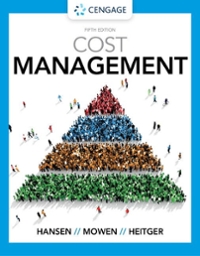Answered step by step
Verified Expert Solution
Question
1 Approved Answer
QUESTION 9 A LIFO liquidation means which of the following: The firm uses the LIFO cost flow assumption, and it is insolvent. It must liquidate
QUESTION 9
- A LIFO liquidation means which of the following:
- The firm uses the LIFO cost flow assumption, and it is insolvent. It must liquidate all of its inventory.
- The firm did not purchase enough inventory units in the current period to cover its sales for the current period. It must sell its older inventory units that were valued at a lower price. Thus, its gross profit will be higher than expected.
- The firm did not purchase enough inventory units in the current period to cover its sales for the current period. It must sell its older inventory units that were valued at a lower price. Thus, its gross profit will be lower than expected.
- The firm did not purchase enough inventory units in the current period to cover its sales for the current period. It must sell its older inventory units that were valued at a higher price. Thus, its gross profit will be higher than expected.
- None of these answers is correct.
5 points
QUESTION 10
- The new bookkeeper forgot to record the payment of an accounts payable to a supplier. What impact does this have on the company's books?
- No effect
- Cash is understated/the Income Statement is understated
- Cash is overstated/the Income Statement is overstated
- Cash is overstated/liabilities are understated
- Cash is overstated/liabilities are overstated
5 points
QUESTION 11
- The new bookkeeper forgot to record the sale of merchandise that was made to a customer on account with 20% profit. What impact does this have on the company's books?
- Cash is understated/Accounts receivable is understated/Inventory is overstated/Income statement is understated
- Accounts receivable is understated/Inventory is understated/Income statement is overstated
- Cash is overstated/Inventory is understated/Income statement is overstated
- Accounts receivable is understated/Inventory is overstated/Income statement is understated
- Cash is understated/Accounts receivable is overstated/Income statement is understated
5 points
QUESTION 12
- Common stock on the balance sheet is always valued at:
- Paid-in Capital plus Retained Earnings
- Paid-in Capital plus Retained Earnings minus Treasury Shares
- Par value times shares issued
- Par value times shares authorized
- Par value times shares outstanding
5 points
QUESTION 13
- What is the difference between dividends that are declared and dividends that are paid?
- There is no difference
- When they are declared they reduce Net Income and when they are paid they reduce cash
- When they are declared they increase Net Income and when they are paid they reduce cash
- When they are declared they reduce Common Stock and when they are paid they increase Dividends Payable
- When they are declared they reduce Retained Earnings and when they are paid they reduce Dividends Payable
Step by Step Solution
There are 3 Steps involved in it
Step: 1

Get Instant Access to Expert-Tailored Solutions
See step-by-step solutions with expert insights and AI powered tools for academic success
Step: 2

Step: 3

Ace Your Homework with AI
Get the answers you need in no time with our AI-driven, step-by-step assistance
Get Started


